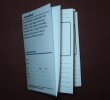The PocketMod is a small book with guides on each page. These guides or templates, combined with a unique folding style, enable a normal piece of paper to become the ultimate note card.
 The interest of pocketmod lies in the way it merges several useful related ideas into a single, solid initiative. There’s a set of handy templates (or mods, as they call them) to choose from; an intuitive application to arrange them into a custom notebook; a way to make this application as accesible as possible (you can either design and print the notebook right from the browser, or download the software and use it offline); a clever folding pattern so that the notebook is quickly made from the printed piece of paper; and a tool to convert previously made documents (in pdf format) to a ready-to-fold booklet (or series of booklets, if needed).
The interest of pocketmod lies in the way it merges several useful related ideas into a single, solid initiative. There’s a set of handy templates (or mods, as they call them) to choose from; an intuitive application to arrange them into a custom notebook; a way to make this application as accesible as possible (you can either design and print the notebook right from the browser, or download the software and use it offline); a clever folding pattern so that the notebook is quickly made from the printed piece of paper; and a tool to convert previously made documents (in pdf format) to a ready-to-fold booklet (or series of booklets, if needed).
I find that the folding technique leaves too much paper unused (one side, actually), but after trying several alternatives I believe that actually the authors went for the easiest way to get the book ready. Anyway, the forum is a good source for further mods and ideas. Now you can say goodbye to sketching on paper napkins!
ps. Still, if you must use a napkin, remember the folding pattern: you’ll get a notebook as small as it is cool 🙂
Related Article: All you need to make a notebook
 kirigami is a paper craft where shapes are literally brought out of paper by cutting and folding (some origami models require cuts, but those are exceptions, so to say: in kirigami, cutting is an intrinsic part of the making of the models). The models themselves can be designed either by hand or aided by the computer; in this latter case 3D Card Maker allows you to create fairly complex designs with just a little practice. All the work is done in a single window where the model is shown in 3D, and moving, rotating or scaling it is straightforward. The interface is easy to understand (first steps: move the cursor with the keyboard arrows, raise columns by pressing the space bar), and provides very useful functions, like the mirror mode, which saves half the work when creating symmetric patterns, or the animation feature, which shows how the model should be folded after cutting. Finally, you can directly print the unfolded pattern, export it as a bmp image, or even export the tridimensional model as a DXF. In all, 3D Card Maker is a very nice program which will keep you entertained for quite a long time.
kirigami is a paper craft where shapes are literally brought out of paper by cutting and folding (some origami models require cuts, but those are exceptions, so to say: in kirigami, cutting is an intrinsic part of the making of the models). The models themselves can be designed either by hand or aided by the computer; in this latter case 3D Card Maker allows you to create fairly complex designs with just a little practice. All the work is done in a single window where the model is shown in 3D, and moving, rotating or scaling it is straightforward. The interface is easy to understand (first steps: move the cursor with the keyboard arrows, raise columns by pressing the space bar), and provides very useful functions, like the mirror mode, which saves half the work when creating symmetric patterns, or the animation feature, which shows how the model should be folded after cutting. Finally, you can directly print the unfolded pattern, export it as a bmp image, or even export the tridimensional model as a DXF. In all, 3D Card Maker is a very nice program which will keep you entertained for quite a long time.
